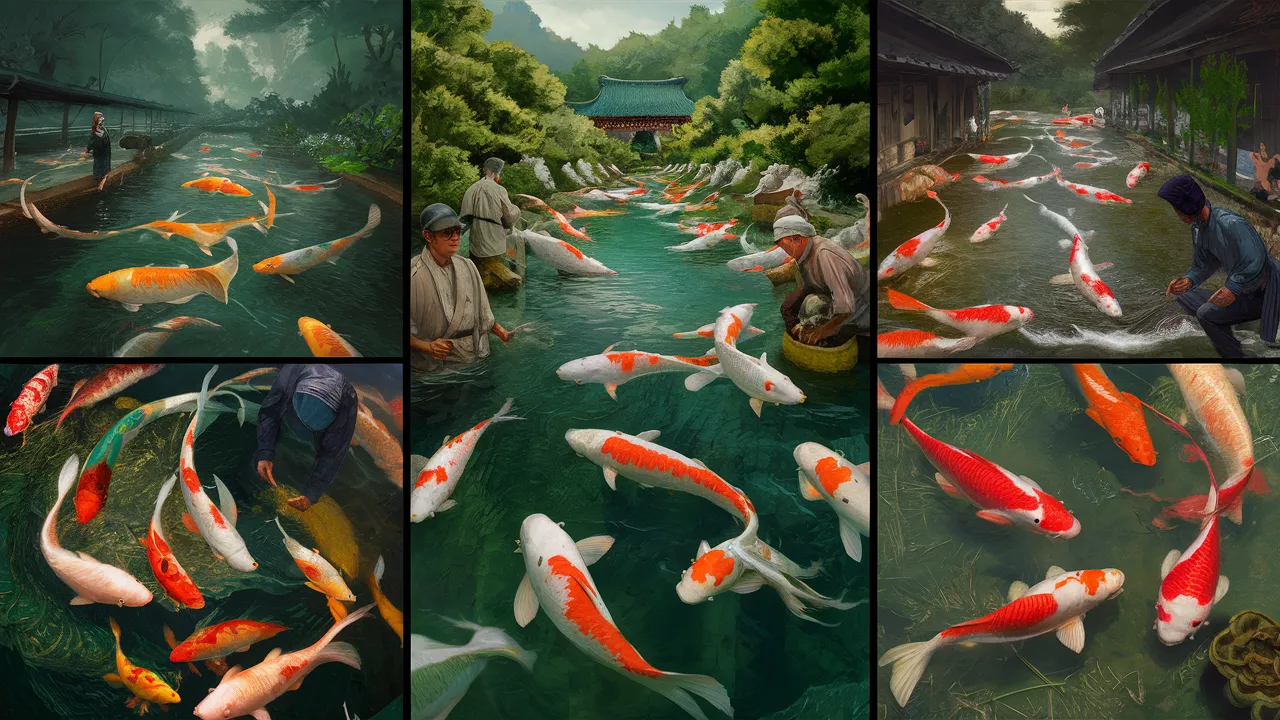Japan is renowned for its rich culture, stunning landscapes, and, of course, its exquisite koi fish. Japanese koi farms are not just places to breed these beautiful fish; they are the epicenters of koi culture, where tradition meets innovation. Koi Fish Information explores the fascinating world of Japanese koi farms, the intricacies of breeding, and the market for high-value koi, including the allure of the two million dollar Koi.
The Significance of Koi in Japanese Culture
Koi fish hold a special place in Japanese culture, symbolizing perseverance, strength, and good fortune. The Japanese word for koi, “鯉,” can also mean “love” or “affection.” This cultural significance has led to the development of a thriving industry focused on breeding and raising these stunning fish.
Koi fish were originally bred for food in Japan, dating back to the 19th century. Over time, selective breeding began to focus on color and patterns, leading to the creation of the beautiful koi varieties we see today. The practice of koi breeding quickly evolved into an art form, with specific traits and colors highly sought after.
Japanese Koi Farms: A Closer Look

Overview of Koi Farms
Japanese koi farms are typically located in rural areas, often near natural water sources to ensure optimal water quality. These farms range from small family-owned operations to large commercial enterprises, each contributing to the koi market in unique ways.
Key Features of Japanese Koi Farms
- Water Quality: Maintaining pristine water conditions is essential for healthy koi. Most farms use natural spring water or well water, which is carefully filtered and monitored.
- Breeding Techniques: Breeders employ selective breeding techniques to enhance specific traits, such as color, pattern, and body shape. This process can take years and involves careful selection of parent koi.
- Pond Design: Koi farms typically feature multiple ponds, each designed for different stages of koi development. Young koi (fry) are often raised in shallow ponds, while mature koi are kept in deeper, larger ponds.
The Breeding Process
Breeding koi is an intricate process that requires knowledge, patience, and a deep understanding of genetics.
Selecting Parent Koi
Breeders select parent koi based on their appearance, health, and genetic lineage. The goal is to combine desirable traits to produce offspring with enhanced colors and patterns.
Spawning
The spawning process usually occurs in the spring when water temperatures begin to rise. Breeders create optimal conditions by raising the water temperature and using spawning mats to encourage the females to lay eggs.
Raising Fry
Once the eggs hatch, the fry are carefully monitored and raised in controlled environments. They require specific diets and water conditions to thrive during their early stages of life.
The Market for Koi: High-Value Fish
The Allure of High-Value Koi
The koi market is known for producing some of the most expensive fish in the world. A prime example is the two million dollar koi, which highlights the extreme value that certain koi can command.
Factors Influencing Koi Value
- Color and Pattern: The most sought-after koi exhibit vibrant colors and unique patterns. Rare combinations can significantly boost a koi’s value.
- Size: Larger koi are often more valuable, especially if they have been well cared for and exhibit desirable traits.
- Bloodline: Koi with prestigious bloodlines or those bred by renowned breeders can command higher prices due to their pedigree.
Notable Sales
The sale of a two million dollar koi is often a headline-making event. These high-value koi are usually sold at auctions, where collectors and enthusiasts vie for the opportunity to own a piece of koi history.
Visiting Japanese Koi Farms
For koi enthusiasts, visiting a Japanese koi farm can be a dream come true. Many farms offer guided tours, allowing visitors to see the breeding process up close and learn about koi care and maintenance.
What to Expect on a Farm Tour
- Guided Walkthroughs: Visitors are often guided through the various ponds, learning about the different koi varieties and breeding techniques.
- Educational Resources: Many farms provide educational materials, including brochures and videos, to enhance the visitor experience.
- Koi Sales: Some farms offer koi for sale, allowing enthusiasts to purchase their own koi directly from the breeder.
The Future of Koi Farming in Japan
As the global demand for koi continues to grow, Japanese koi farms are adapting to new trends and technologies. The focus on sustainability and environmental responsibility is becoming increasingly important in the industry.
Sustainable Practices
Many koi farms are implementing sustainable practices to reduce their environmental impact. This includes:
- Water Conservation: Utilizing advanced filtration systems to minimize water waste.
- Natural Feeding: Incorporating organic feeding practices to promote healthier koi.
Technological Advancements
The use of technology in koi breeding is also on the rise, with farms utilizing advanced monitoring systems to track water quality, fish health, and growth rates.
Conclusion
Japanese koi farms are the heart of koi breeding, where tradition and innovation come together to produce some of the most beautiful fish in the world. With a deep cultural significance and a thriving market, koi fish, including high-value specimens like the two million dollar koi, continue to captivate enthusiasts globally.

Related Posts
Are Betta Fish Nocturnal? Understanding Their Sleep Patterns
Exploring the Types of Neocaridina Shrimp
Male vs Female Koi: The Differences and Characteristics